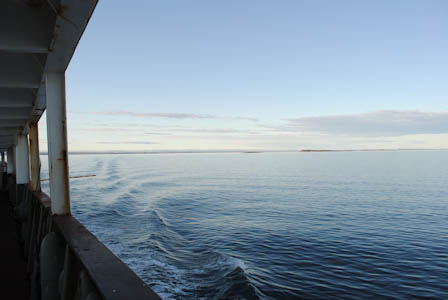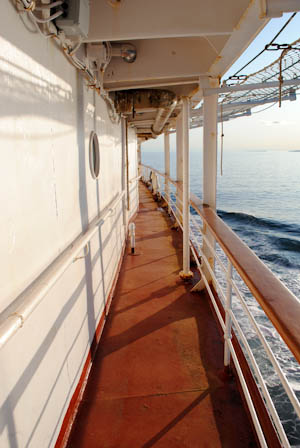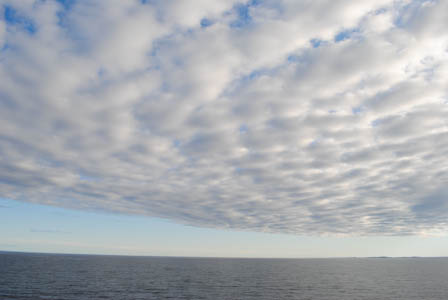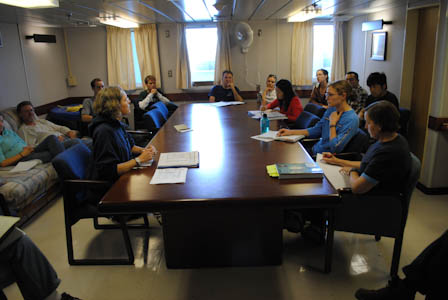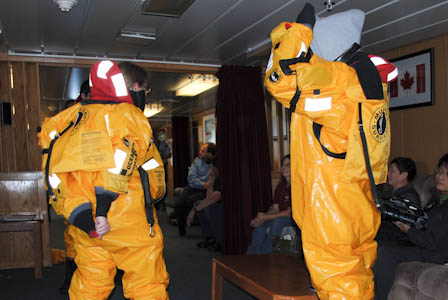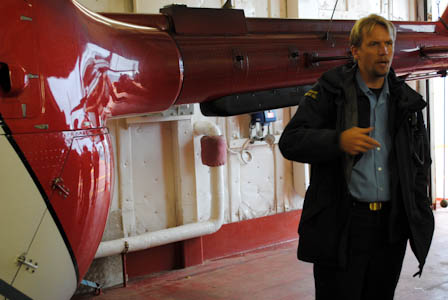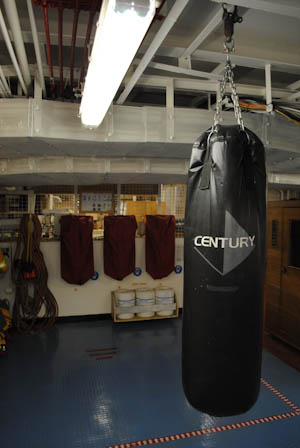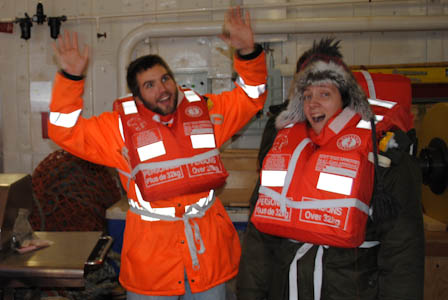Alex KainSeptember 18, 2009At around 8:30 this morning, the engines surged, the water churned, and the CCGS Louis S.-St. Laurent began a one-month journey through ice-covered seas. Although we're now coasting through the ocean, the ship doesn't feel much different when it's in motion. The faint sound of water sloshing against the bow and the occasional rumble of the hull remind us that we're in motion, but otherwise the generator's hum sounds throughout the lower hallways the same as it did yesterday when we were anchored in Coronation Gulf. The hum sounds like it's coming from an odd hybrid of a leaf blower and a laser printer.
Shipboard life continues uninterrupted. Researchers are still unpacking and organizing for tomorrow, when sample gathering and analysis begins. The entire scientific team convened this morning for a meeting led by chief scientist Sarah Zimmerman. We discussed the everyone's preliminary progress and coordinated for the first bit of field work, tomorrow's deployment of a Conductivity, Temperature, and Depth monitor (CTD) and plankton nets at the mooring site AG-5, in the Amundsen Gulf.
Just after lunchtime, all scientists and new crew members followed Derek, the ship's second mate, around the boat for a safety and familiarization training. Derek explained to everyone the ship's alarm system. Among other meanings, a sustained blast signifies fire or man overboard. Seven short blasts followed a sustained blast means stop whatever you are doing, find a lifejacket, put on something waterproof and warm, and get to the nearest lifeboat. For practice, everyone donned a waterproof emergency suit, which, though completely waterproof and functional, could double as Halloween costumes for children dressing as moon men. Derek directed everyone to the lifeboats and explained where to go, should one never happen, in the event of an emergency. Navigating ice-covered waters presents manifold risks, but everyone feels secure knowing that the crew of the Louis are so well prepared for unexpected emergencies.
Derek also gave us a thorough tour of the ship, though it remains a confusing multi-tiered network of hallways and stairwells.
Canadian Coast Guard sailors and Arctic oceanographers consider the CCGS Louis S.-St. Laurent the Queen Mary II of the ice-covered world. The ship is fully equipped with scientific labs, equipment, and huge cranes necessary to move all required gear, but it also boasts amenities more common to cruise liners than research vessels. During the tour we saw the ship's gym, sauna, and lounge, featuring an HDTV with a satellite hookup. Above about 79 degrees North, our destination in about a week, the ship is too far North to pick up a satellite signal.
Dinner progressed with typical conversation until our emergency training suddenly became necessary. The alarm blared in a sustained strident tone. A disaster! What tragedy! What loss! What cruel, cruel fate! Actually, it was just a drill. As instructed earlier in the day, we put on life jackets, bundled up, and headed to the helicopter hangar to await further instruction. Next we went to our assigned ship stations to prepare for a pretend evacuation.
Tomorrow we plan to meet a fuel barge off the coast of Tuktoyaktuk and fill up the Louis's two million liter gas tank, a task that requires most of a day. To put that in perspective, 2 million liters of gasoline weighs 700 metric tons and occupies the same volume as 40,000 Honda Civic gas tanks or 25 residential swimming pools. Once we're filled up, we're ready to go for the duration of the expedition. In fact, with a full tank of gas, the Louis can operate at sea for approximately six months. A fine vessel she is. All text and photos property of Alex Kain.
Last updated: October 7, 2019 | |||||||||||||||||||||||||||||||
Copyright ©2007 Woods Hole Oceanographic Institution, All Rights Reserved, Privacy Policy. | |||||||||||||||||||||||||||||||


